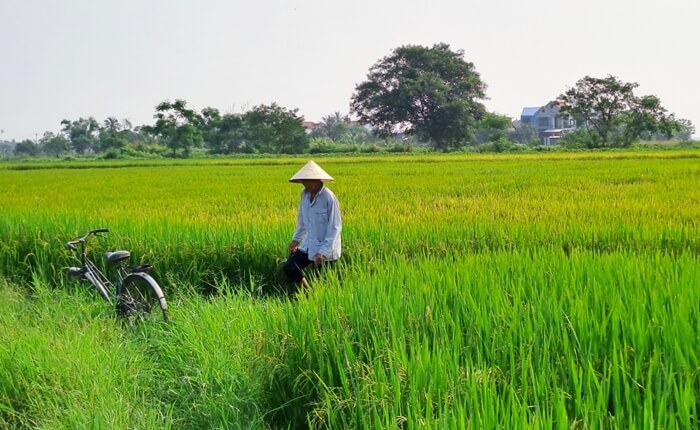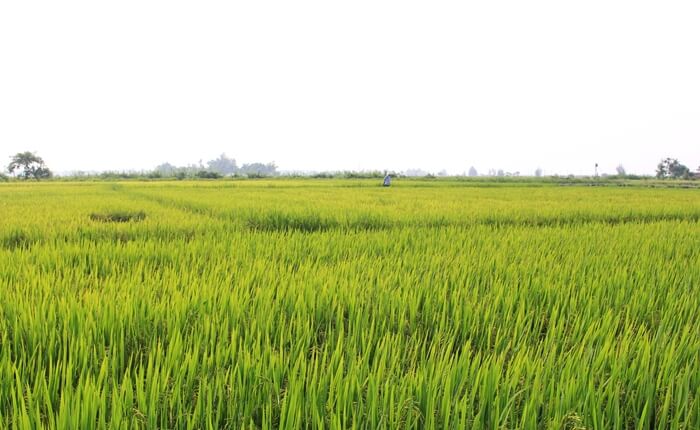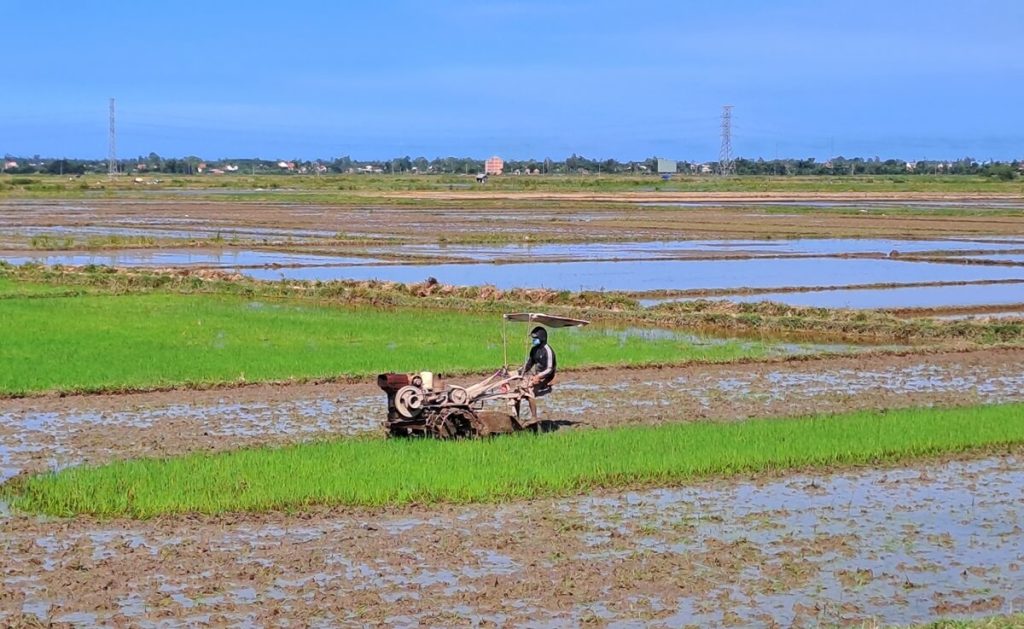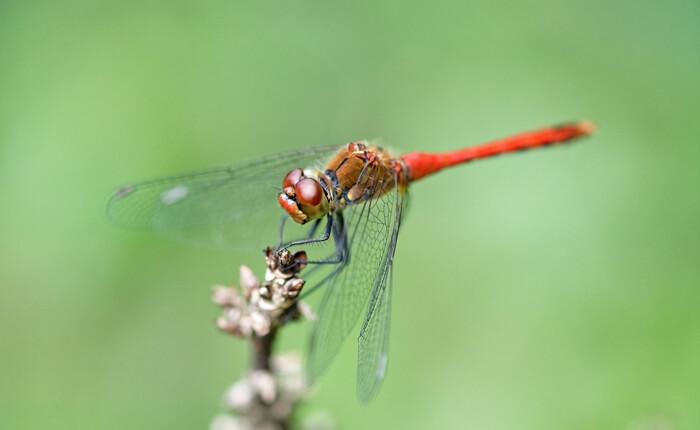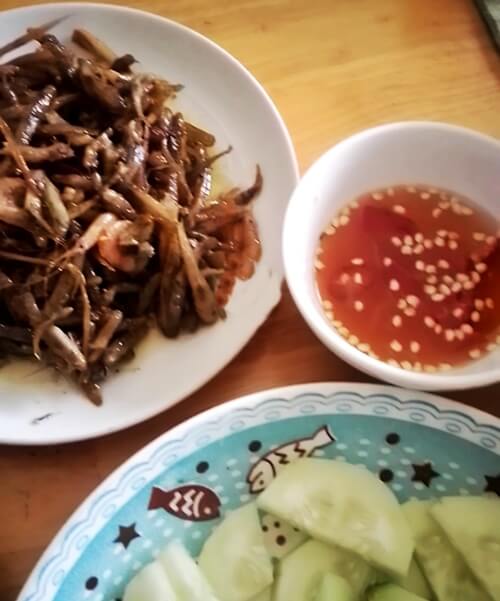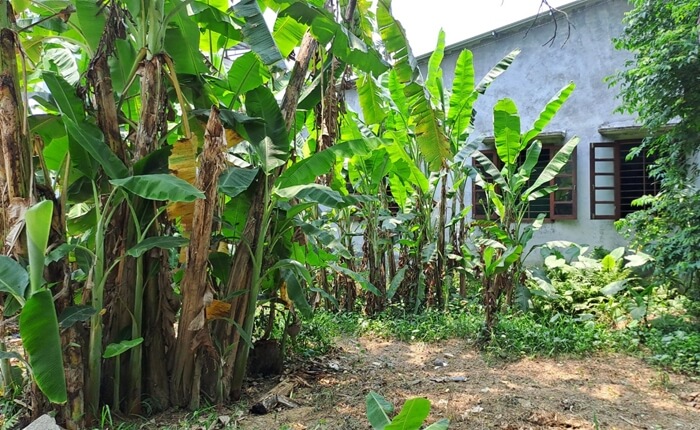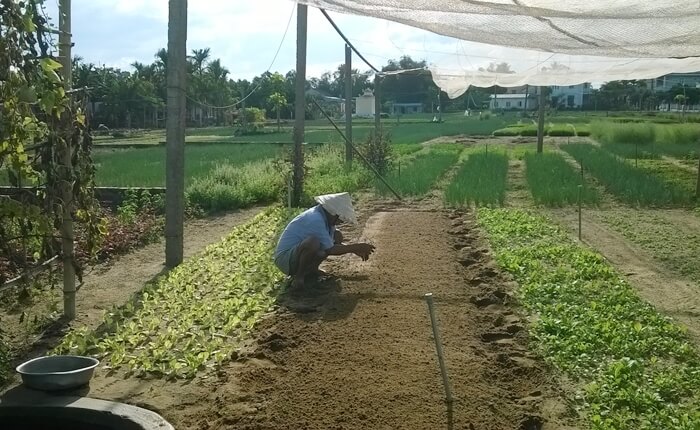Born into a farming family in the countryside, I’m still proud to be part of the Vietnamese farmers – the largest workforce here, even though I’ve worked in the tourism industry.
As an agricultural country, the peasantry gets eighty percent of laborers in the rural regions, which takes very important roles to contribute to developing life and maintaining enough food for domestic needs and exports.
In the article, I will cover all the main things about farmers in this country. Now go deeper below!
1. How are the works of farmers in Vietnam?
When mentioning Vietnam, many guests think of the big rice fields because the country exports over 7 million tons of rice per year to other countries.
Of course, the main works of almost all farmers are in the rice fields. Growing rice, taking care of rice – for example, watering it, cleaning grass in the paddy to help rice plants grow better, fertilizing it, spraying insects if any, and harvesting.
Besides working in the rice paddy, many farmers in Vietnam spend their time in coffee farms – typically in the Central Highlands where lots of coffee trees are grown to export. Also, they work in vegetable farms to care for various vegetables for everyday life.
The farmers’ working day comes at 5:30 a.m. when the sky is still cool, taking a break when it’s too hot at noon, and coming back to work until 5:00 p.m. or 6:00 p.m.
2. What do they use for work?
Machines for plowing the rice paddy before a new crop or harvesting rice can be used in various regions of the country now. However, you may see a few buffalos working at small land sections for rice or vegetable farms. This is because buffalos are still cheap and convenient in small remote areas.
Human labor is also needed for working in the fields and on farms. The farmer’s hand working takes the rest of the work that the machine cannot do, such as fertilizing, watering small lands, fixing big spaces in the paddy, cleaning old leaves in vegetable farms, collecting sweet potatoes, and harvesting coffee fruits.
Two small tools – hoes and sickles – are vital for the Vietnamese people working on the farm. They use hoes to make the soil soft, dig holes for plants, and clean grass around the trees. Sickles are used for cutting rice and grass, collecting vegetables, and picking fruits.
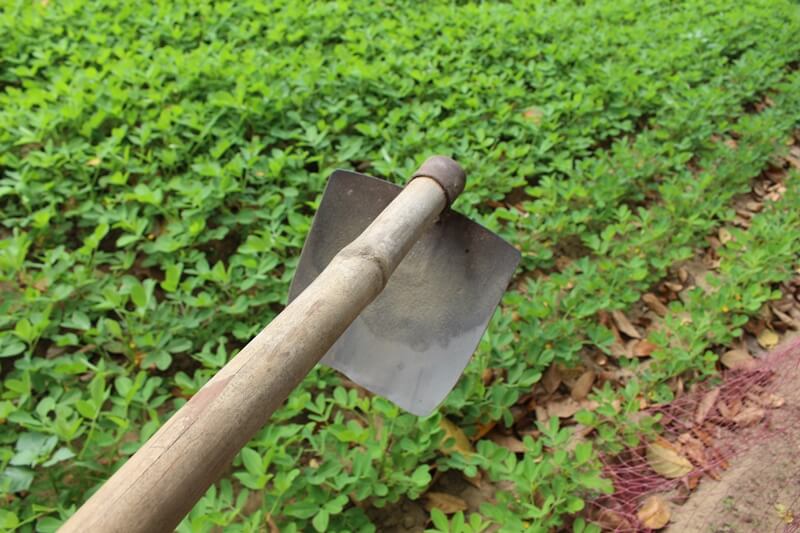

In general, although machines for farming come to Vietnam, many farmers still use their human power to work. It is because the machines are expensive, and different families in the countryside own small lands in scattered regions.
3. Experiences of Vietnamese farmers
A lot of Vietnamese farmers work based on their experiences, not using any modern tools. They still guess the weather by looking at the sky, animals, or the moon to know when to prepare the seeds for growing new crops or collecting their products.
- “Tháng 8 dòm ra, tháng 3 dòm vào” means in English “The eighth lunar month needs to see the North sky, the third lunar month needs to see the South sky”. This means that looking at the sky following around the months mentioned if you see a cloud in that area, it may rain soon.
- “Chuồn chuồn bay thấp thì mưa, bay cao thì nắng, bay vừa thì râm” means when you see the dragonflies fly low (from 1 – 1.5 meters from the ground), it may rain soon; they flies at high (above 2 m from the ground), it is sunny; they flies medium level (over 1.5 – 2 m from the ground), it may be cloudy with title rain.
- “Trăng quầng trời hạn, trăng tán trời mưa” means the round light around the moon, it may be sunny; the light spreads from the moon, it may rain.
- Looking at the ants, they move up the wall with their eggs from underground, it may rain and flood soon.
These are the basic experiences, telling about the weather to farmers, which can help them prepare to grow new plants or collect crops on time to escape from the bad weather.
4. What do the farmers in Vietnam often cook and eat?
When you come to the restaurants in Vietnam to taste food, almost are not the same ones that the farmers eat every day. Their food is not fancy, not very colorful, and does not have nice decoration as in shops.
They have steamed rice in everyday life, adding fish sauce, and one to three other dishes boiled – fried – or stewed, including vegetables, eggs, fish, or meats (pork, beef, or chicken).
In general, farmers have more rice, vegetables, and fish than other foods. In my opinion, although they can fill their stomach with plenty of steamed rice, it’s not enough energy and protein to work hard in the field, so most of them are very thin.
Farmers eat breakfast early, 5:30 a.m. – 6:30 a.m., before going to the farms. And, lunch can also be early from 11:30 a.m. – 12:00 p.m. An important Vietnamese meal comes at dinner when the whole family members stay together from 5:30 p.m. to 7:30 p.m. However, between each meal, they can have brunch in the morning and drink Vietnamese tea with cakes in the afternoon.
5. What do Vietnamese farmers grow in their gardens?
Most houses in the countryside have big gardens. Besides working in the fields and farms, they also grow a lot of plants and animals in their gardens to get more food, which can improve the quality of meals.
You can find a lot of free-range chickens in gardens in the villages in Vietnam. Pigs, cows, and buffalos are taken care of in big caves like small houses.
Plenty of green Vietnamese vegetables – such as salad, cabbage, sponge, lemon, and eggplant can supply vitamins for them. Easy-growing trees such as bananas grow everywhere. Also, of course, you can look at various Vietnamese herbs as well, which are often present in their fragrant food.
If possible, joining a family dinner in the countryside in the Mekong Delta can give you a good chance of going into the gardens. Or, staying at a homestay (real homestay), you may know more about their local culture.
6. What do farmers wear when working?
Working mainly in the rice field under the hot weather, the costumes of farmers often have these features:
- They are simple, which helps them work and move easily.
- Clothes have dark colors to reduce dirt looking.
- The shirts often have long sleeves to protect their skin from the sun and others.
- They like to wear conical hats that help them avoid hot sunny heat.
- In the past, most Vietnamese farmers went into the mud in the rice fields with bare feet. Now, many use plastic boots to protect themselves and avoid cold water during winter, typically in North Vietnam.
When you travel to Vietnam, you can see an image of farmers with conical hats, and brown or dark clothes working in the paddy fields.
To improve the experience, many travel companies in Vietnam run eco-tours, which give you a chance to become a farmer explore his work, and wear traditional dresses.
You can find a few tours, such as:
- In Hoi An (Central Vietnam), you can join a half-day tour in Tra Que vegetable village to learn how to grow rice.
- In the Mekong Delta (South Vietnam), you can learn how to catch fish in the mud.
- In Hanoi (North Vietnam), an eco-tour helps you learn how to grow and water vegetables.
These eco-tours cannot cover all the activities of farmers in Vietnam and their lives, but the tours can support you to experience little or more of what they do. These activities will become bonus feelings for you to understand more about the farmer’s life.
